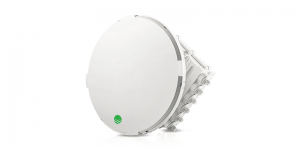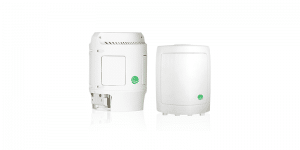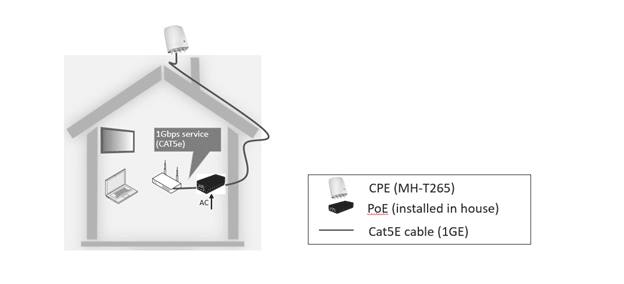RDOF Frequently Asked Questions
To qualify for RFOD funding, each winning bidder should submit FCC Long Form 683 with details about its operation, legal, funding, and technical aspects of the solution.
The relevant questions are on pages 23-25 of the form: “Spectrum Access”, “Technology and system design description” and in the Public Notice on pages 96-98, under the “Terrestrial Fixed Wireless”.
Additional questions are found in the Procedures for Rural Digital Opportunity Fund Auction which contains the operational questions of the short form in Appendix A.
This document helps service providers to answer technology-related questions using a gigabit fixed wireless access solution.
Solution overview:
Gigabit FWA Solution
Gigabit Fixed Wireless Solution relies on providing wireless connectivity using millimeter wave spectrum in E and V-bands.
E-band PtP radio: EH-8010

These devices are point-to-point radios that are usually installed on towers or roof-tops.
Capacity: up to 10Gbps FD
Distance: up to 6 miles, Line of sight
Interface: Ethernet, fiber, and copper
V-band Mesh-PtMP radio: MH-N366

These devices are usually deployed at the street level, and bridge the last 1,000 to deliver gigabit capacity to the end-users.
The system is composed of the base station (MH-N365)
Capacity: up to 15Gbps, with 360 deg omni coverage, up to 60 terminals
Distance: up to 1,000 feet, Line of sight
Interface: Ethernet, copper, and fiber
The terminal unit (or the CPE) supports the following characteristics:
Capacity: 1Gbps
Distance: up to 1,000 feet, Line of sight
Interface: Ethernet, copper, and fiber
Best practices show that two baseline topologies are deployed by service providers:
Gigabit to isolated locations – suitable for up to 10 locations
The solution relies on gigabit point-to-point radios. One radio is installed on a tower or a tall building that has a fiber point of presence. The second side is installed on the customer premise. To provide the gigabit service the radios should operate in mmWave frequency and can co-exist with other radios in this band without causing interference. The solution will provide a gigabit service with up to 6 miles radius. Requires single cable installation. PoE or DC power. And priced starting from $2,500 per link including radios antennas, mounting kits, and power supplies.

Gigabit to pocket communities – suitable for 100’s of locations
This use case assumes some homes’ density. The solution includes 2 components: the backhaul link that is described in the previous paragraph and the access network. To provide gigabit service, the access network should be implemented using mmWave mesh technology. The base station unit (BU) provides 360 coverage and a range of up to 1,000 ft. The base station can serve up to 60 gigabit-capable terminal units. This is the most cost-efficient technology to provide gigabit access. The $/home passed is starting from $100.

The performance of every wireless system is subject to environmental conditions and the required availability.
Performance calculation for all Siklu by Ceragon radios can be calculated using an online Link Budget Calculator: http://lbc.siklu.com/
Siklu by Ceragon has developed a wireless planning tool to simplify the planning process of advanced gigabit wireless networks.
With WiNDE you can design a gigabit wireless network using the most advanced Terragraph technology in just a matter of minutes. Generate BOM and instantly calculate business case for any use case: business connectivity, residential FWA, smart city wireless network, and RDOF rural designs.
WiNDE brings your wireless workplace to one place. You can easily integrate it with existing designs, identify RDOF service areas, and even individual customers, add resiliency and point-to-point connections. WiNDE supports networks at any scale.
To start using WiNDE: https://planner.siklu.com/
Long-form 683:
Spectrum access
To comply with RDOF requirements and deliver Gigabit capacity with low latency using the FWA solution, the service provider needs to utilize a 60 or 70/80 GHz spectrum.
The 57GHz to 71GHz band is called the “V-band”. It has 14GHz of unlicensed spectrum. There are both point-to-point products and point to multipoint products operating in this band that will deliver the gigabit services. The capacities of these systems range from 1Gbps up to 2Gbps aggregate with TDD (Time Division Duplex) Duplexing. Most deployments will use solutions in this band for last-mile access.

E-band spectrum ranges from 71-76GHz and 81-86GHz.
EH-8010 supports flexible channels and frequency configuration: 250, 500, 1,250 and 2,000 MHz.
The 2,000MHz channel is used to achieve 10Gbps FD capacity.



MH-N366 supports 4 channels in the V-band with the following central frequencies: 58.32, 60.48, 62.64, or 64.80, and utilizes 2,160MHz bandwidth.
Full system description can be found on Siklu’s partners portal:
E-band is a lightly licensed band. Each link should be registered. It costs $75/link for 10 years. The registration is done online. Siklu provides a comprehensive guide on how to register the link, it can be found here: https://go.siklu.com/fcc-registration-process-lp
And a service to register the radios for you: https://www.siklu.com/support/online-fcc-link-registration/
V-band is an unlicensed band and doesn’t require any registration or coordination.
Technology and system design description
The radio performance is calculated using industry-standard ITU propagation models: ITU-R P.837-5 and ITU-R P.838-3 and system gain of the radios. These models consider rain attenuation and oxygen absorption to provide a reliable performance estimate.
Performance calculation for all Siklu by Ceragon radios can be calculated using an online Link Budget Calculator: http://lbc.siklu.com/
Siklu by Ceragon also provides PathLoss file to all the radios, it can be found on the customers portal.
Coverage analysis can be done using WiNDE. Please contact support@siklu.com for assistance.
Detailed RAN design is generated using WiNDE, Siklu’s planning tool. Please contact support@siklu.com for assistance.
The radio performance is calculated using industry-standard ITU propagation models: ITU-R P.837-5 and ITU-R P.838-3 and system gain of the radios. These models consider rain attenuation and oxygen absorption to provide a reliable performance estimate.
All Siklu by Ceragon equipment implements the Layer2 protocol. To implement capacity management and traffic engineering, the following supported protocols can be used:
- Transparent bridge IEEE 802.1d
- VLAN IEEE 802.1q
- Provider bridge IEEE 802.1ad
The management of the equipment is implemented using CLI/SSH/SNMP protocols.
Detailed equipment specifications can be found in the customer portal:
All Siklu by Ceragon radios support gigabit throughput with sub 100 microseconds latency.
This unit has one copper Gigabit-Ethernet port and is powered by PoE.

The unit is connected using CAT5 cable through the PoE to the residential gateway/wifi router.


 by
by 

